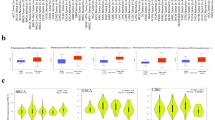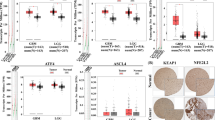Abstract
Purpose
Medulloblastoma (MB) is a malignant brain disease in young children. The overall survival of MB patients is disappointing due to absence of effective therapeutics and this could be attributed to the lack of molecular mechanism underlying MB. FHOD3 was an important gene during cardio-genesis and was reported to promote cell migration in cancer. However, its role in MB is not clear to date.
Methods
RT-qPCR and IHC analysis were used to determine expression of FHOD3. Survival curve was drawn by K–M analysis. FHOD3 was knocked down by RNAi technology. The effects of FHOD3 on medulloblastoma cells were determined by CCK-8 assay, colony formation assay, transwell assay and FACs analysis.
Results
FHOD3 expression increased by 1.5 fold in tumor tissues compared to the control and IHC analysis further confirmed strong expression of FHOD3 in medulloblastoma tissues. Then higher FHOD3 expression was associated with shorter survival time in MB patients (13.0 months versus 43.8 months). In medulloblastoma cells such as Daoy and D283med, FHOD3 also displayed abundant expression. When FHOD3 was knocked down, the ability of cell proliferation and colony formation was reduced over greatly. The capability of cell migration and invasion was also inhibited significantly. However, cell apoptotic rate increased significantly reversely. Mechanistically, the phosphorylation level of RhoA, ROCK1, and LIMK1 was decreased when FHOD3 was knocked down but increased reversely when FHOD3 was over-expressed in Daoy cells.
Conclusions
FHOD3 was associated with overall survival time in medulloblastoma patients and was essential to cell proliferation, growth and survival in medulloblastoma and might regulates activation of RhoA/ROCK1/LIMK1 signaling pathway.








Similar content being viewed by others
References
Katoh M, Katoh M. Identification and characterization of human FHOD3 gene in silico. Int J Mol Med. 2004;13:615–20.
Taniguchi K, Takeya R, Suetsugu S, Kan-O M, Narusawa M, Shiose A, et al. Mammalian formin fhod3 regulates actin assembly and sarcomere organization in striated muscles. J Biol Chem. 2009;284:29873–81.
Kan-O M, Takeya R, Abe T, Kitajima N, Nishida M, Tominaga R, et al. MammalianforminFhod3 plays an essential role in cardiogenesis by organizing myofibrillogenesis. Biol Open. 2012;1:889–96.
Dwyer J, Pluess M, Iskratsch T, Dos Remedios CG, Ehler E. The formin FHOD1 in cardiomyocytes. Ant Rec (Hoboken). 2014;297:1560–70.
Wooten EC, Hebl VB, Wolf MJ, Greytak SR, Orr NM, Draper I, et al. Formin homology 2 domain containing 3 variants associated with hypertrophic cardiomyopathy. Circ Cardiovasc Genet. 2013;6:10–8.
Zhou Q, Wei SS, Wang H, Wang Q, Li W, Li G, et al. Crucial role of ROCK2-mediated phosphorylation and upregulation of FHOD3 in the pathogenesis of angiotensin II-induced cardiac hypertrophy. Hypertension. 2017;69:1070–83.
Ochoa JP, Sabater-Molina M, Garcia-Pinilla JM, Mogensen J, Restrepo-Cordoba A, Palomino-Doza J, et al. Formin homology 2 domain containing 3 (FHOD3) is a genetic basis for hypertrophic cardiomyopathy. J Am Coll Cardiol. 2018;72:2457–67.
Huang S, Pu T, Wei W, Xu R, Wu Y. Exome sequencing identifies a FHOD3 p.S527del mutation in a Chinese family with hypertrophic cardiomyopathy. J Gene Med. 2019;19:e3146.
French D, Yang W, Cheng C, Raimondi SC, Mullighan CG, Downing JR, et al. Acquired variation outweighs inherited variation in whole genome analysis of methotrexate polyglutamate accumulation in leukemia. Blood. 2009;113:4512–20.
Paul NR, Allen JL, Chapman A, Morlan-Mairal M, Zindy E, Jacquemet G, et al. α5β1 integrin recycling promotes Arp2/3-independent cancer cell invasion via the formin FHOD3. J Cell Biol. 2015;210:1013–31.
Hetmanski JH, Zindy E, Schwartz JM, Caswell PT. A MAPK-driven feedback loop suppresses rac activity to promote rhoa-driven cancer cell invasion. PLoS Comput Biol. 2016;12:e1004909.
Chai L, Li J, Lv Z. An integrated analysis of cancer genes in thyroid cancer. Oncol Rep. 2016;35:962–70.
Monzo P, Chong YK, Guetta-Terrier C, Krishnasamy A, Sathe SR, Yim EK, et al. Mechanical confinement triggers glioma linear migration dependent on formin FHOD3. Mol Biol Cell. 2016;27:1246–61.
Millard NE, De Braganca KC. Medulloblastoma. J Child Neurol. 2016;31:1341–53.
Quinlan A, Rizzolo D. Understanding medulloblastoma. JAAPA. 2017;30:30–6.
Massimino M, et al. Childhood medulloblastoma. Crit Rev Oncol Hematol. 2016;105:35–51.
Massimino M, Biassoni V, Gandola L, Garre ML, Gatta G, Giangaspero F, et al. Childhood medulloblastoma. Crit Rev Oncol Hematol. 2016;105:35–51.
Bowers DC, Gargan L, Weprin B, Mulne A, Elterman RD, Munoz L, et al. Impact of site of tumor recurrence upon survival for children with recurrent or progressive medulloblastoma. J Neuro Surg. 2007;107(1 Suppl):5–10.
Kline CN, Joseph NM, Grenert JP, van Ziffle J, Talevich E, Onodera C, et al. Targeted next-generation sequencing of pediatric neuro-oncology patients improves diagnosis, identifies pathogenic germline mutations, and directs targeted therapy. Neuro Oncol. 2017;19:699–709.
Cavalli FMG, Remke M, Rampasek L, Peacock J, Shih DJH, Luu B, et al. Intertumoral heterogeneity within medulloblastoma subgroups. Cancer Cell. 2017;31:737–54.
Livak KJ, Schmittgen TD. Analysis of relative gene expression data using real-time quantative PCR and the 2-△△CT method. Methods. 2001;25:402–8.
Hu CP, Zhou HY, Liu YL, Huang JB, Liu WY, Zhang Q, et al. ROCK1 promotes migration and invasion of non-small-cell lung cancer cells through the PTEN/PI3K/FAK pathway. Int J Oncol. 2019;55:833–44.
Zhou WD, Wang X, Sun XZ, Hu J, Zhang RR, Hong Z. Actein induces apoptosis in leukemia cells through suppressing RhoA/ROCK1 signaling pathway. Int J Oncol. 2017;51:1831–41.
Guo D, Li Y, Chen Y, Zhang D, Wang X, Lu G, et al. DANCR promotes HCC progression and regulates EMT by sponging miR-27a-3p via ROCK1/LIMK1/COFILIN1 pathway. Cell Prolif. 2019;51:e12628.
Topalian SL, Hodi FS, Brahmer JR, et al. Safety, activity, and immune correlates of anti-PD1 antibody in cancer. N Engl J Med. 2012;366:2443–544.
Wang ZG, Wu ZQ, Liu Y, Han WD. New development in CAR-T cell therapy. J Hematol Oncol. 2017;10:53.
McGranahan N, Swanton C. Clonal heterogeneity and tumor evolution: past, present, and the future. Cell. 2017;168:613–28.
Degllnnocenti A, di Leo N, Ciofani G. Genetic hallmarks and heterogeneity of glioblastoma in the single-cell omics era. Adv Ther (Weinh). 2020. https://doi.org/10.1002/adtp.201900152.
Wang SY, Liechty B, Patel S, et al. Programmed death ligand 1 expression and tumor infiltrating lymphocytes in neurofibromatosis type 1 and 2 associated tumors. J Neuro oncol. 2018;138:183–90.
Hanahan D, Weinberg RA. Hallmarks of cancer: the next generation. Cell. 2011;144:646–74.
Yeh HW, Lee SS, Chang CY, Lang YD, Jou YS. A new switch for TGFβ in cancer. Cancer Res. 2019;79:3797–805.
Kuhn S, Geyer M. Formins as effector proteins of Rho GTPases. Small GTPases. 2014;5:e29513.
Haga RB, Ridley AJ. Rho GTPases: regulation and roles in cancer cell biology. Small GTPases. 2016;7:207–21.
Etienne-Manneville S, Hall A. Rho GTPases in cell biology. Nature. 2002;420:629–35.
Heasman SJ, Ridley AJ. Mammalian Rho GTPases: new insights into their functions from in vivo studies. Nat Rev Mol Cell Biol. 2008;9:690–701.
Hayes MN, McCarthy K, Jin A, Oliveira ML, Iyer S, Garcia SP, et al. Vangl2/RhoA signaling pathway regulates stem cell self-renewal programs and growth in rhabdomyosarcoma. Cell St Cell. 2018;22:414–27.
Zhang GY, Yang WH, Chen Z. Upregulated STAT3 and RhoA signaling in colorectal cancer (CRC) regulate the invasion and migration of CRC cells. Eur Rev Med Pharmacol Sci. 2016;20:20208–2037.
Zhang G, Zhu F, Han G, Li Z, Yu Q, Li Z, et al. Silencing of URG11 expression inhibits the proliferation and epithelial-mesenchymal transition in benign prostatic hyperplasia cells via the RhoA/ROCK1 pathway. Mol Med Rep. 2018;18:391–8.
Yin M, Lu Q, Liu X, Wang T, Liu Y, Chen L. Silencing Drp1 inhibits glioma cells proliferation and invasion by RHOA/ROCK1 pathway. Biochem Biophys Res Commun. 2016;478:663–8.
Scott RW, Olson MF. LIM kinases: function, regulation and association with human disease. J Mol Med (Berl). 2007;85:555–68.
Lee MH, Kundu JK, Chae JI, Shim JH. Targeting ROCK/LIMK/cofilin signaling pathway in cancer. Arch Pharm Res. 2019;42:481–91.
Yu JZ, Li H. The expression of FAT1 is associated with overall survival in children with medulloblastoma. Tumori J. 2017;103:44–52.
Acknowledgements
This study was supported by grants from the Shanghai Municipal Health and Family Planning Commission (NSFS No. 20164Y0086) and Shanghai Anticancer Association EYAS PROJECT (SACA-CY1C03).
Author information
Authors and Affiliations
Corresponding author
Ethics declarations
Conflict of interests
All authors declare that they have no conflict of interest.
Ethical statement
All human studies have been approved by the appropriate ethics committee and have, therefore, been performed in accordance with the ethical standards laid down in the 1964 Declaration of Helsinki and its later amendments.
Informed consent
All persons gave their informed consent prior to their inclusion in the study.
Additional information
Publisher's Note
Springer Nature remains neutral with regard to jurisdictional claims in published maps and institutional affiliations.
Rights and permissions
About this article
Cite this article
Yu, J., Shi, W., Zhao, R. et al. FHOD3 promotes carcinogenesis by regulating RhoA/ROCK1/LIMK1 signaling pathway in medulloblastoma. Clin Transl Oncol 22, 2312–2323 (2020). https://doi.org/10.1007/s12094-020-02389-5
Received:
Accepted:
Published:
Issue Date:
DOI: https://doi.org/10.1007/s12094-020-02389-5




